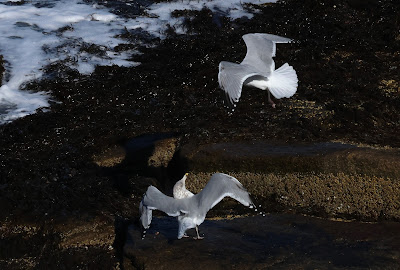The wind had reversed direction and picked up speed since my last report on birds flying past the tip of Halibut Point. Then, the wind was coming briskly from the northeast and a good variety of birds were getting a boost from flying directly into it.
 |
| Sanderlings |
Now on a very blustery day a different set of birds, and far fewer of them, was flying with the westerly wind, toward the east.
 |
| Common Eider |
In both cases the birds were flying primarily from left to right but with different approaches to harnessing the wind. I had to speculate on whether they were seizing opportunities for intentional travel or simply making the best of elements forced on them.
 |
Ring-billed Gull bucking the wind |
Gulls were the exception to
the pattern of the down-wind travelers. They patrolled both up and down the
shoreline using the wind to hover and maneuver adroitly in all directions.
Their ability to shape their wings and tail in broad, cup-like configurations
helped keep them aloft.
 |
Herring Gulls contesting a morsel |
When they were in travelling mode, however, gulls harnessed the wind with preferences similar to other maritime flyers, wings straight, narrowed and extended.
 |
| Northern Gannet |
Gannets are one of the most spectacular aerialists along the Halibut Point shoreline. The proportion of their long wing length to narrow width forms what is known as a high aspect ratio that facilitates maximum lift with minimum drag and turbulence, as the moving air creates a vacuum above the wing curvature.
 |
Seasonal range of the
Northern Gannet
|
 |
Cory's Shearwater |
The wings of shearwaters optimize the high aspect ratio principle to control and stabilize their flight near the water surface in all kinds of winds. They spend most of their life far from land but are occasionally pushed close enough to shore to be seen from our coast in late summer or early fall. When forced in by a gale like other seabirds they follow a counterclockwise loop around the edge of the Ipswich Bay to escape back out to sea past Halibut Point.
 |
Migratory range of
Cory's Shearwater
|
 |
| Dynamic soaring |
"Dynamic stability exploits the fact that winds blowing over the surface of the sea are slowed by the waves at the surface and gradually increase in velocity with altitude. Relatively heavy birds such as albatrosses, fulmars, and shearwaters with high aspect ratios (best for control and stability) can gain speed high in the fastest air and then plunge downwind; when they reach the slower air near the seas surface they then use their momentum to head up again, simultaneously turning into the wind, which blows them back aloft. The entire sophisticated maneuver is performed without a single flap."

👁👍👁
ReplyDelete